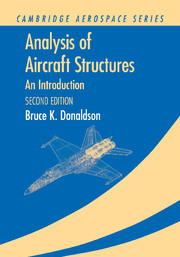Book contents
- Frontmatter
- Contents
- Introduction to the Second Edition
- Introduction to the First Edition
- List of Repeated Engineering Symbols
- Acknowledgments
- Part I The Fundamentals of Structural Analysis
- 1 Stress in Structures
- 2 Stresses and Coordinate Axis Rotations
- 3 Displacements and Strains
- 4 Strains in Rotated Coordinate Systems
- 5 The Mechanical Behavior of Engineering Materials
- 6 Linearly Elastic Materials
- Part II **Introduction to the Theory of Elasticity**
- Part III Engineering Theory for Straight, Long Beams
- Part IV Work and Energy Principles
- Part V Energy-Based Numerical Solutions
- Part VI Thin Plate Theory and Structural Stability
- Appendix A Additional Topics
- Appendix B Selected Answers to Exercises
- References
- Index
2 - Stresses and Coordinate Axis Rotations
from Part I - The Fundamentals of Structural Analysis
Published online by Cambridge University Press: 05 June 2012
- Frontmatter
- Contents
- Introduction to the Second Edition
- Introduction to the First Edition
- List of Repeated Engineering Symbols
- Acknowledgments
- Part I The Fundamentals of Structural Analysis
- 1 Stress in Structures
- 2 Stresses and Coordinate Axis Rotations
- 3 Displacements and Strains
- 4 Strains in Rotated Coordinate Systems
- 5 The Mechanical Behavior of Engineering Materials
- 6 Linearly Elastic Materials
- Part II **Introduction to the Theory of Elasticity**
- Part III Engineering Theory for Straight, Long Beams
- Part IV Work and Energy Principles
- Part V Energy-Based Numerical Solutions
- Part VI Thin Plate Theory and Structural Stability
- Appendix A Additional Topics
- Appendix B Selected Answers to Exercises
- References
- Index
Summary
Introduction
In Chapter 1 the choice of the origin and orientation of the analysis Cartesian coordinate system was made arbitrarily. For a body of general shape there simply is no geometric feature with which to align the coordinate system for the advantage of the analyst. Even if the structure has a special geometry that clearly suggests an advantage for a particular origin or orientation of a Cartesian coordinate system, it is still necessary to consider the following question. What effect would there be upon the analysis results (e.g., the calculated values of the stresses) if another Cartesian coordinate system were selected that is different from the first in its origin and orientation? In general, the answer is that the set of stresses associated with the second Cartesian coordinate system are different from those that are associated with the first Cartesian coordinate system. For example, consider the first bar of Fig. 1.1 (a). If the first Cartesian coordinate system is such that the x axis runs along the length of the bar, then with the end forces applied as uniform tractions, the first set of stresses would be σxx = N/A with the other five stresses equal to zero. Similarly, if the second Cartesian coordinate system were such that the y axis ran the length of the bar, the second set of stresses would be σyy = N/A with the other five stresses equal to zero.
- Type
- Chapter
- Information
- Analysis of Aircraft StructuresAn Introduction, pp. 38 - 67Publisher: Cambridge University PressPrint publication year: 2008



